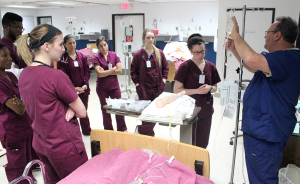Economic development | Enrollment | Budget | Nursing | Housing | International enrollment | Crime | Greek life


When walking around the campus, students can be seen eating, heading to class or enjoying the day. Those students wearing maroon scrubs with an MSU patch on the sleeve and textbooks in their hands are members of the nursing program. The nursing program is one of the leading programs offered by the school.
Kathleen Williamson, chair and associate professor of nursing, said, “Nursing has always been a valued profession and an ethical profession.”
The nursing program has a high retention rate for graduating, according to Williamson.
Amanda Irby, nursing sophomore, said, “When applying for colleges I looked for the ones with the best nursing program, and Midwestern State always showed up.”
The nursing program accounted for 11.2 percent of MSU graduates in 2014.
Irby said, “I picked the school specifically for the nursing program, because if a school puts in so much effort to keep such a high ranking for the program, then I am sure it will give me the best education in that area that I can get.”
Williamson said, “Our program’s platform is a bachelor’s degree as a registered nurse, but there are so many opportunities for nurses after that.”
Almost every registered nurse is employed upon graduating from the program, Williamson said.
Elam Lazo, a sophomore in nursing, said, “I picked this school because of everything it offers to nursing, not just stopping at a bachelor’s degree.”
The school offers multiple undergraduate degrees and three graduate degrees.
Irby said, “I don’t plan to stop at my bachelor’s degree, so having the choice and opportunity here to further my education really helped in my selection process for schools.”
Williamson said, “What makes our program unique is the longevity of it. The professors here have been here for a long time and are truly vested in student learning.”
 A majority of the professors in the nursing program have been teaching at the school for many years and had work experience before teaching. Many of the professors have their own practice or clinic and still work while teaching.
A majority of the professors in the nursing program have been teaching at the school for many years and had work experience before teaching. Many of the professors have their own practice or clinic and still work while teaching.
Irby said, “During orientation and visitation to the school, I was able to talk to some of the professors here, and I was amazed at how much experience they have in the field, and how much they enjoyed explaining their work to us. That moved me, and ensured that I wanted to stay in the healthcare field.”
A simulation center was created off campus in Jan. 2005, with a full-time staff of nursing educators to help teach students in real-life scenarios.
Williamson said, “Our simulation center has mannequins that can breathe and talk to you. You can stick and put everything in them, and they are meant to give you scenarios that you will see in the real world.”
Students are tested individually and in groups. The center tests in respiratory, child bearing, mother care and more to provide students with a wide range of scenarios.
Lazo said, “I was very interested in the simulation center. Testing like that rather than just sitting in a classroom all day is much more beneficial and intriguing to me. The school teaching us hands on is much different than hearing about it, and that will prepare me for the real world and how to handle the situations better.”
Nursing was offered at the school as an associate’s degree until the 1960s, when it was changed to a bachelor’s degree and then built as a program.
Williamson said, “The legacy and history of the program is what creates the buzz for it. We have been here and the longevity of it is what makes this program unique.”
According to Williamson, the long time dream and passion of wanting to become a nurse, and get through the rigorous courses keeps the program alive. The pride of graduating after so much hard work creates this feeling that she hopes to provide to the students.
Williamson said, “I don’t see the trend changing in any way. The opportunity for growth is much greater for graduate and undergraduate students.”
















